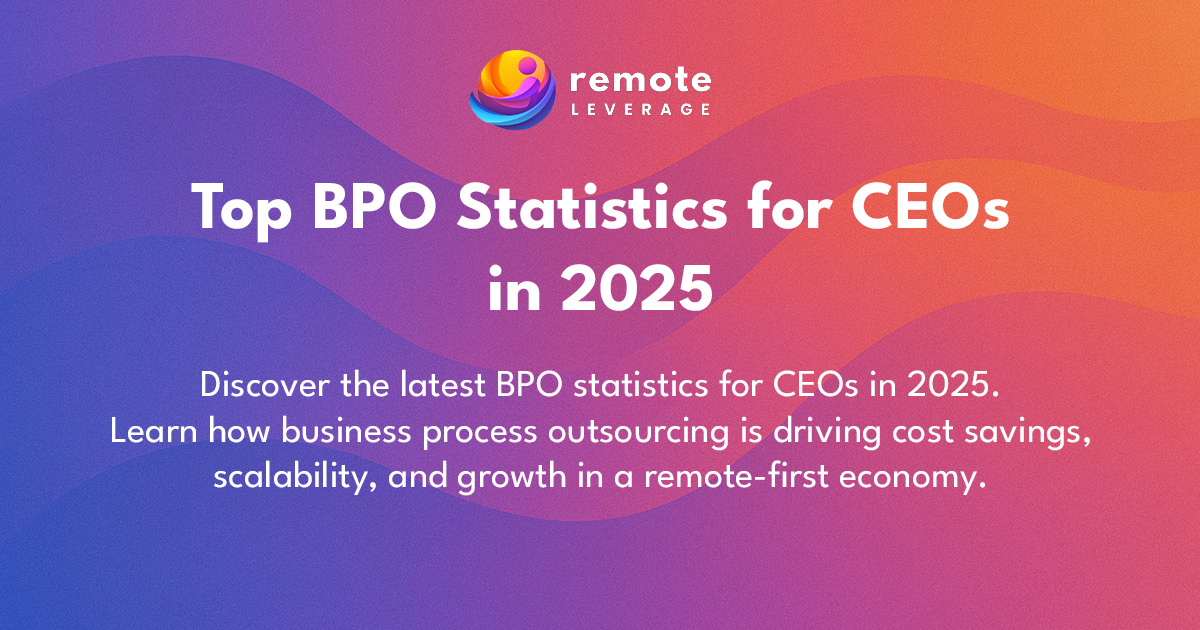
Business process outsourcing (BPO) isn’t just for massive corporations anymore. In 2025, it’s one of the most strategic moves CEOs can make to reduce costs, increase efficiency, and scale operations without adding overhead.
Whether you’re running a startup, a mid-sized firm, or an enterprise-level company, the latest BPO trends and statistics tell a clear story: outsourcing isn’t optional—it’s essential.
In this article, we break down the most relevant and up-to-date BPO statistics for 2025, explain what they mean for your business, and offer insights you can act on.
Business process outsourcing (BPO) involves contracting third-party service providers to handle non-core tasks such as customer support, HR, IT services, accounting, and back-office operations.
What’s changed in 2025? BPO is no longer just about saving money—it’s about building lean, agile, and global-first businesses.
Here are the numbers that matter, explained in plain language.
1. The Global BPO Market is Worth $435 Billion in 2025
According to Statista, the BPO industry is projected to hit $435 billion this year, up from $260 billion just a few years ago.
What this means: The demand for outsourcing is growing rapidly. CEOs across industries are investing in BPO to stay competitive, streamline processes, and scale smarter.
2. 70% of Companies Use Outsourcing to Reduce Costs
Cost savings remain the primary driver of BPO adoption. Outsourcing can reduce labor and operational costs by 30% to 70%, depending on the role and location.
Key insight: For many CEOs, BPO offers an immediate return on investment. By outsourcing administrative or repetitive tasks, businesses can reinvest those savings into innovation and growth.
3. 45% of Global Workforces Are Now Remote or Hybrid
As remote work becomes the norm, outsourcing fits seamlessly into modern team structures. Virtual assistants, offshore teams, and global contractors are now a standard part of workforce planning.
Why this matters: BPO enables CEOs to extend their teams globally without increasing physical infrastructure or local headcount.
4. 65% of Executives Say Outsourcing Boosts Business Agility
A Deloitte survey found that agility is a top reason companies outsource. Outsourcing allows businesses to respond quickly to changes in market demand, customer needs, or operational bottlenecks.
Takeaway: CEOs who embrace BPO gain a flexible workforce that can scale up or down as needed.
5. Customer Support Is the Most Outsourced Business Function
Over 59% of companies outsource customer support to external partners or virtual teams.
What this tells us: Customer support is a high-effort, low-margin task for many organizations. Outsourcing it improves service availability while reducing strain on in-house staff.
6. 92% of G2000 Companies Use IT Outsourcing
Even the world’s largest companies outsource. From cybersecurity to cloud services to application support, IT outsourcing is now a standard part of enterprise strategy.
Lesson for CEOs: If your company isn’t outsourcing IT or tech operations yet, you’re likely falling behind on speed, innovation, or cost-efficiency.
7. SMBs Are Leading BPO Growth
Small and medium-sized businesses are now the fastest adopters of outsourcing services. They see BPO as a way to compete with larger firms by leveling the playing field with skilled, remote talent.
Good to know: You don’t need to be a Fortune 500 company to benefit from outsourcing. Even small businesses can outsource functions like bookkeeping, social media, or executive assistance and see immediate gains.
8. 77% of Companies Plan to Increase Their Use of Outsourcing
The vast majority of organizations surveyed say they will expand their outsourcing over the next 12 to 24 months.
CEO insight: Outsourcing is not a passing phase. It’s a long-term strategy that supports scalability, talent access, and business resilience.
Understanding these trends isn’t just about staying informed—it’s about leading strategically.
As a CEO, your focus is on:
Outsourcing is one of the few strategies that checks all of those boxes.
Q: Is BPO only for large companies?
Not at all. In fact, small and mid-sized businesses are driving much of the growth in BPO adoption today. With virtual platforms and remote teams, outsourcing is more accessible than ever.
Q: Is outsourcing safe and reliable?
Yes—if you work with the right providers. Reputable BPO agencies offer clear contracts, data security protocols, and proven talent pools to reduce risk.
Q: What tasks should I outsource first?
Start with time-consuming, repeatable tasks such as customer service, admin work, data entry, bookkeeping, lead generation, and calendar management.
Q: How do I measure success with BPO?
Use KPIs like cost savings, task completion rates, response times, and customer satisfaction. With clear metrics and expectations, outsourced teams can be just as accountable as in-house employees.
The numbers are clear. Outsourcing is no longer just an option for cutting costs—it’s a proven strategy for scaling smarter, accessing top talent, and staying competitive in a rapidly evolving marketplace.
The CEOs who understand and act on these BPO trends today will be the ones leading tomorrow.
At Remote Leverage, we help forward-thinking CEOs and business leaders outsource confidently. From virtual assistants to operational support, we’ll help you scale your team and set up systems that drive results.
✅ Available in your time zone
✅ Professional, reliable, and fully trained
👉 Book a discovery call to learn how outsourcing can accelerate your growth in 2025.